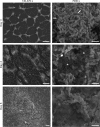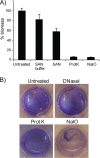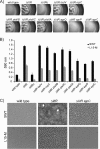LitR is a repressor of syp genes and has a temperature-sensitive regulatory effect on biofilm formation and colony morphology in Vibrio (Aliivibrio) salmonicida
- PMID: 24973072
- PMCID: PMC4136084
- DOI: 10.1128/AEM.01239-14
LitR is a repressor of syp genes and has a temperature-sensitive regulatory effect on biofilm formation and colony morphology in Vibrio (Aliivibrio) salmonicida
Abstract
Vibrio (Aliivibrio) salmonicida is the etiological agent of cold water vibriosis, a disease in farmed Atlantic salmon (Salmo salar) that is kept under control due to an effective vaccine. A seawater temperature below 12°C is normally required for disease development. Quorum sensing (QS) is a cell density-regulated communication system that bacteria use to coordinate activities involved in colonization and pathogenesis, and we have previously shown that inactivation of the QS master regulator LitR attenuates the V. salmonicida strain LFI1238 in a fish model. We show here that strain LFI1238 and a panel of naturally occurring V. salmonicida strains are poor biofilm producers. Inactivation of litR in the LFI1238 strain enhances medium- and temperature-dependent adhesion, rugose colony morphology, and biofilm formation. Chemical treatment and electron microscopy of the biofilm identified an extracellular matrix consisting mainly of a fibrous network, proteins, and polysaccharides. Further, by microarray analysis of planktonic and biofilm cells, we identified a number of genes regulated by LitR and, among these, were homologues of the Vibrio fischeri symbiosis polysaccharide (syp) genes. The syp genes were regulated by LitR in both planktonic and biofilm lifestyle analyses. Disruption of syp genes in the V. salmonicida ΔlitR mutant alleviated adhesion, rugose colony morphology, and biofilm formation. Hence, LitR is a repressor of syp transcription that is necessary for expression of the phenotypes examined. The regulatory effect of LitR on colony morphology and biofilm formation is temperature sensitive and weak or absent at temperatures above the bacterium's upper threshold for pathogenicity.
Copyright © 2014, American Society for Microbiology. All Rights Reserved.
Figures







Similar articles
-
The alternative sigma factor RpoQ regulates colony morphology, biofilm formation and motility in the fish pathogen Aliivibrio salmonicida.BMC Microbiol. 2018 Sep 12;18(1):116. doi: 10.1186/s12866-018-1258-9. BMC Microbiol. 2018. PMID: 30208852 Free PMC article.
-
LitR of Vibrio salmonicida is a salinity-sensitive quorum-sensing regulator of phenotypes involved in host interactions and virulence.Infect Immun. 2012 May;80(5):1681-9. doi: 10.1128/IAI.06038-11. Epub 2012 Feb 27. Infect Immun. 2012. PMID: 22371373 Free PMC article.
-
Differential expression profiling of ΔlitR and ΔrpoQ mutants reveals insight into QS regulation of motility, adhesion and biofilm formation in Aliivibrio salmonicida.BMC Genomics. 2019 Mar 15;20(1):220. doi: 10.1186/s12864-019-5594-4. BMC Genomics. 2019. PMID: 30876404 Free PMC article.
-
Cold-water vibriosis. The current status of knowledge.J Fish Dis. 2017 Jan;40(1):119-126. doi: 10.1111/jfd.12465. Epub 2016 Apr 13. J Fish Dis. 2017. PMID: 27072873 Review.
-
Biofilm formation of pathogenic bacteria isolated from aquatic animals.Arch Microbiol. 2022 Dec 24;205(1):36. doi: 10.1007/s00203-022-03332-8. Arch Microbiol. 2022. PMID: 36565346 Review.
Cited by
-
Aliivibrio wodanis as a production host: development of genetic tools for expression of cold-active enzymes.Microb Cell Fact. 2019 Nov 11;18(1):197. doi: 10.1186/s12934-019-1247-1. Microb Cell Fact. 2019. PMID: 31711487 Free PMC article.
-
Establishing a Role for Bacterial Cellulose in Environmental Interactions: Lessons Learned from Diverse Biofilm-Producing Proteobacteria.Front Microbiol. 2015 Nov 17;6:1282. doi: 10.3389/fmicb.2015.01282. eCollection 2015. Front Microbiol. 2015. PMID: 26635751 Free PMC article. Review.
-
Quorum sensing in Aliivibrio wodanis 06/09/139 and its role in controlling various phenotypic traits.PeerJ. 2021 Aug 24;9:e11980. doi: 10.7717/peerj.11980. eCollection 2021. PeerJ. 2021. PMID: 34513327 Free PMC article.
-
LitR and its quorum-sensing regulators modulate biofilm formation by Vibrio fischeri.J Bacteriol. 2025 Feb 20;207(2):e0047624. doi: 10.1128/jb.00476-24. Epub 2025 Jan 29. J Bacteriol. 2025. PMID: 39878466 Free PMC article.
-
The alternative sigma factor RpoQ regulates colony morphology, biofilm formation and motility in the fish pathogen Aliivibrio salmonicida.BMC Microbiol. 2018 Sep 12;18(1):116. doi: 10.1186/s12866-018-1258-9. BMC Microbiol. 2018. PMID: 30208852 Free PMC article.
References
Publication types
MeSH terms
Substances
Associated data
- Actions
- Actions
- Actions
- Actions
- Actions
- Actions
- Actions
- Actions
- Actions
- Actions
- Actions
LinkOut - more resources
Full Text Sources
Other Literature Sources
Molecular Biology Databases

